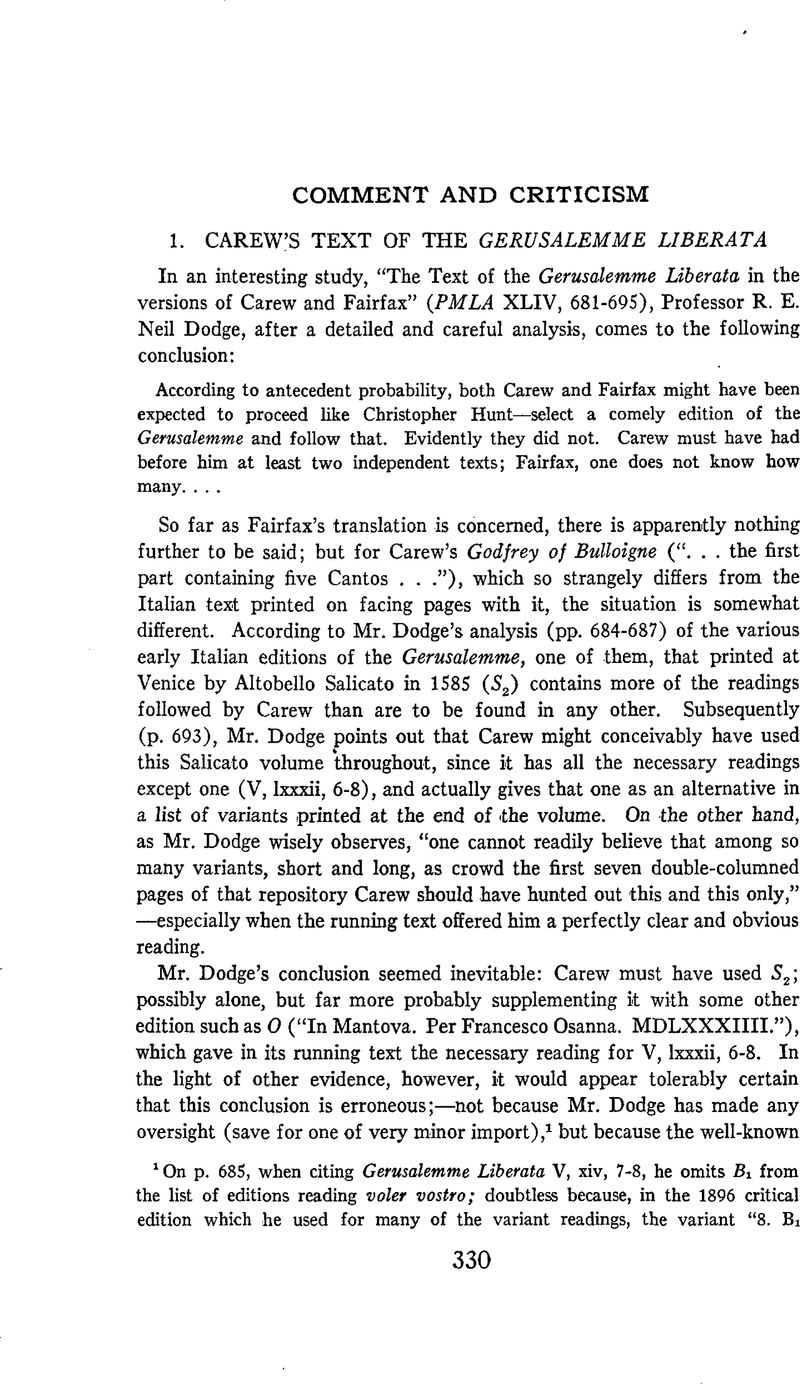No CrossRef data available.
Published online by Cambridge University Press: 02 December 2020

1 On p. 685, when citing Gerusalemme Liberata V, xiv, 7-8, he omits B1 from the list of editions reading voler vostro; doubtless because, in the 1896 critical edition which he used for many of the variant readings, the variant “8. B1 voler vostro” is printed curiously out of place. (See vol. II, p. 172 of that edition.)
This does not materially affect Mr. Dodge's ultimate results, except as putting B 1 definitely ahead of B 2 in the running; S 2 still remains the most important of the three.
2 The reading of S 2 is this :
Ne potrai de la vergine regale
Fra i campioni legittimi meschiarti.
Illegittimo servo è chi (riprende
Cruccioso il giovinetto) a me il contende.
3 The fact that a major pause is here indicated by a mere comma is essentially unimportant, especially considering the absence of all punctuation at the end of the preceding line. We should expect to-day a period, not a comma, after servo; but Cinquecento usage was not by any means consistent in such matters, and constantly differed from the modern norm. On the same page of M, as the present passage (f. 26v.), for example, there are two other cases of a comma where the modern text has a period: stanza 77, end of v. 2; and st. 85, end of v. 2.
What is really decisive in the present case, however, is the fact that Carew's version also is printed with a comma at this point and not a period:
Nor mongst her lawful champions mayst thou bee
Allowd to trace this royall virgins path,
Servant of lawlesse rate, and who (replies
The youth now waxed hoat) it me denies?
(Neil Dodge, loc. cit., p. 686.)
4 The table of variants also gives a third reading; but since the running text and the one variant corrected each other so well, while the other variant was somewhat at odds with both, the translator's course was obvious. The rejected variant, however, may perhaps incidentally have served to emphasize the reading of the last lines as a question :
. . . Illegitimo servo, e chi potrallo,
Ripiglia id Giovinetto, à me vietallo?
It is particularly significant that none of the three readings supplied by M 3 even remotely suggests the reading given in S 2; but all three give, two exactly and the third approximately, the form of Carew's version.
5 It must however be observed that this title is not in any case a direct translation of the title to S 2 : Il Goffredo, Overo Gerusalemme Liberata. . . . This would not give Godfrey of Bulloigne or the Recoverie of Hierusalem . . . , but Godfrey or Hierusalem Recovered. Titles were then (as they still are) quite normally adapted (or even newly invented) rather than translated, with the different public definitely in mind.
6 The present writer has used a copy in his own collection, with the title-page of 1583, and the Cinque Canti at the end. No copy with the 1582 imprint has been available; through the great courtesy of Professors George L. Hamilton, Francis P. Magoun, and Camillo P. Merlino, respectively, it has been ascertained that there is none at Cornell or Harvard, nor at the University of Pennsylvania, which has probably the best Tasso collection in the country.
Since a 1582 copy (M 3) was used for the edizione critica collation, and all copies with the 1583 imprint were neglected on the grounds of their identity with the other, there remains, of course, the bare possibility that Gentile's collation was exact, and that Solerti was mistaken in believing the two texts to be but one. Since Solerti's account, however, is very circumstantial, and since Serassi had already in the eighteenth century noted that the readings of the two editions were identical, one need hardly hesitate: it was surely the youthful G. Gentile, not Solerti, who made the inadequate collation.—If not, then Carew must have used the edition of Venice, Francesco de' Franceschi, 1583, and that alone.
7 “Sic vos non vobis. . . . .” Since my slight (yet fundamental) emendation here is based entirely on Professor Dodge's detailed study, it too is in its essence more his than mine.